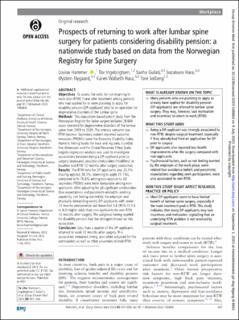| dc.contributor.author | Hammer, Lovise | |
| dc.contributor.author | Ingebrigtsen, Tor | |
| dc.contributor.author | Gulati, Sasha | |
| dc.contributor.author | Hara, Sozaburo | |
| dc.contributor.author | Nygaard, Øystein Petter | |
| dc.contributor.author | Hara, Karen Walseth | |
| dc.contributor.author | Solberg, Tore | |
| dc.date.accessioned | 2023-09-12T05:40:06Z | |
| dc.date.available | 2023-09-12T05:40:06Z | |
| dc.date.created | 2023-08-29T12:09:46Z | |
| dc.date.issued | 2023 | |
| dc.identifier.citation | Occupational and Environmental Medicine. 2023, 80 (8), 447-454. | en_US |
| dc.identifier.issn | 1351-0711 | |
| dc.identifier.uri | https://hdl.handle.net/11250/3088741 | |
| dc.description.abstract | Objectives To assess the odds for not returning to work (non-RTW) 1 year after treatment among patients who had applied for or were planning to apply for disability pension (DP-applicant) prior to an operation for degenerative disorders of the lumbar spine.
Methods This population-based cohort study from the Norwegian Registry for Spine surgery included 26 688 cases operated for degenerative disorders of the lumbar spine from 2009 to 2020. The primary outcome was RTW (yes/no). Secondary patient-reported outcome measures (PROMs) were the Oswestry Disability Index, Numeric Rating Scales for back and leg pain, EuroQoL five-dimension and the Global Perceived Effect Scale. Logistic regression analysis was used to investigate associations between being a DP-applicant prior to surgery (exposure), possible confounders (modifiers) at baseline and RTW 12 months after surgery (outcome).
Results The RTW ratio for DP-applicants was 23.1% (having applied: 26.5%, planning to apply 21.1%), compared with 78.6% among non-applicants. All secondary PROMs were more favourable among non-applicants. After adjusting for all significant confounders (low expectations and pessimism related to working capability, not feeling wanted by the employer and physically demanding work), DP-applicants with under 12 months preoperative sick leave had 3.8 (95% CI 1.8 to 8.0) higher odds than non-applicants for non-RTW 12 months after surgery. The subgroup having applied for disability pension had the strongest impact on this association.
Conclusion Less than a quarter of the DP-applicants returned to work 12 months after surgery. This association remained strong, also when adjusted for the confounders as well as other covariates related RTW. | en_US |
| dc.language.iso | eng | en_US |
| dc.publisher | BMJ | en_US |
| dc.rights | Navngivelse-Ikkekommersiell 4.0 Internasjonal | * |
| dc.rights.uri | http://creativecommons.org/licenses/by-nc/4.0/deed.no | * |
| dc.title | Prospects of returning to work after lumbar spine surgery for patients considering disability pension: A nationwide study based on data from the Norwegian Registry for Spine Surgery | en_US |
| dc.title.alternative | Prospects of returning to work after lumbar spine surgery for patients considering disability pension: A nationwide study based on data from the Norwegian Registry for Spine Surgery | en_US |
| dc.type | Peer reviewed | en_US |
| dc.type | Journal article | en_US |
| dc.description.version | publishedVersion | en_US |
| dc.source.pagenumber | 447-454 | en_US |
| dc.source.volume | 80 | en_US |
| dc.source.journal | Occupational and Environmental Medicine | en_US |
| dc.source.issue | 8 | en_US |
| dc.identifier.doi | 10.1136/oemed-2023-108864 | |
| dc.identifier.cristin | 2170544 | |
| cristin.ispublished | true | |
| cristin.fulltext | original | |
| cristin.qualitycode | 2 | |

